-
Content Count
410 -
Joined
-
Last visited
-
Days Won
91
Content Type
Profiles
Forums
Gallery
Calendar
Articles
Store
Posts posted by Des
-
-
1 hour ago, imfishn said:
Amazing insight and information Des, and what a great haul of beautiful fish ...well done
 it all sounds very promising for us keen anglers. Do you think this pattern will also carry through to our metro beaches for YFW?
it all sounds very promising for us keen anglers. Do you think this pattern will also carry through to our metro beaches for YFW?
Warmer water early in the season will certainly bring them into the metro areas earlier. I saw a post from Brighton Tackle claim they had been sighted locally.
As I have previously mentioned the ongoing heavy netting of this species over winter in the last few years is having a significant detrimental impact on the overall stock status. Hopefully they are resilient and bounce back.
-
The seasons are changing. The temperature is rising.
The water is warming. It is all happening a bit earlier this year.
Lizards are crawling on the roads. And “Lizards” (flathead) are crawling in the sea.
Water birds are gathering, lining up for a feast of baitfish from above.
The Flathead are lining up for a feast of baitfish from below.
In these ambient temperatures, food is plentiful in the shallows.
The ecosystem has had a great kickstart with the rise in temperatures and every thing comes alive and thrives on the sandflats.
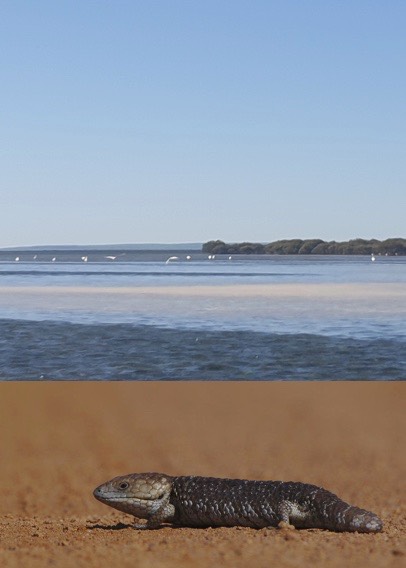
Temperature is the biggest driver for a series of chain reactions, in the sandflats ecosystem.
I am forever monitoring the water temperatures.
The rise in water temperature is early this year.
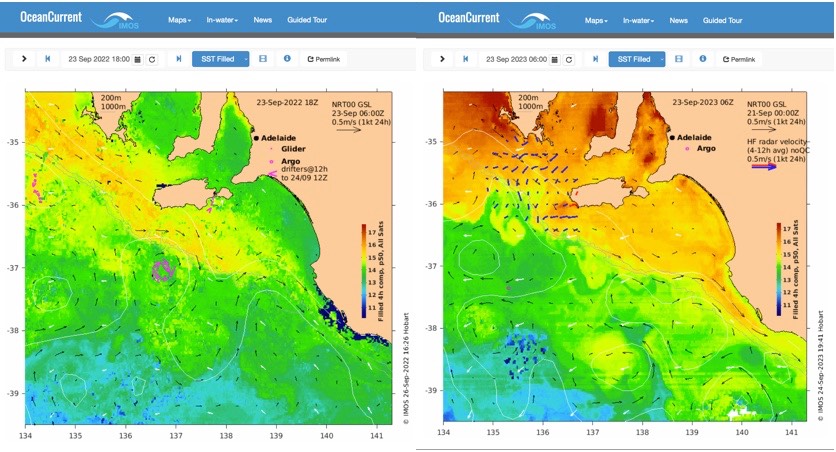
A series of natural events occur, which results in delivering us fishers, some fine Yellow Fin Whiting and Flathead.
Stimulated by the rise in water temperature about now our local Prawns, the Western King Prawn, start spawning in their mid gulf grounds.
Also now, the Haswell Shore Crabs shrug off their cold weather torpor and also spawn in the inshore shallows.
Post larval Juvenile Prawns start migrating from mid gulf to the warmer, shallow, inshore waters of the upper gulfs.
The Haswell Shore Crab larval zoea, now abundant, provides food for the juvenile Prawns and schools of baitfish.
There is a boom in the population of Juvenile Prawns, Haswell Shore Crabs, and Baitfish in the inshore waters … And also their predators. YFW and Flathead, have moved in, enjoying this abundance of food.
Having experienced a sustained period of exposure to higher water temperatures, the YFW have now, increased their metabolisms and have developed voracious appetites. The larger predatory YFW that I like to target are now aggressively hunting on the sandflats. Devouring juvenile prawns and shore crabs.
So it is a perfect time to place myself at the end of these chain reactions and target some YFW and Flathead.
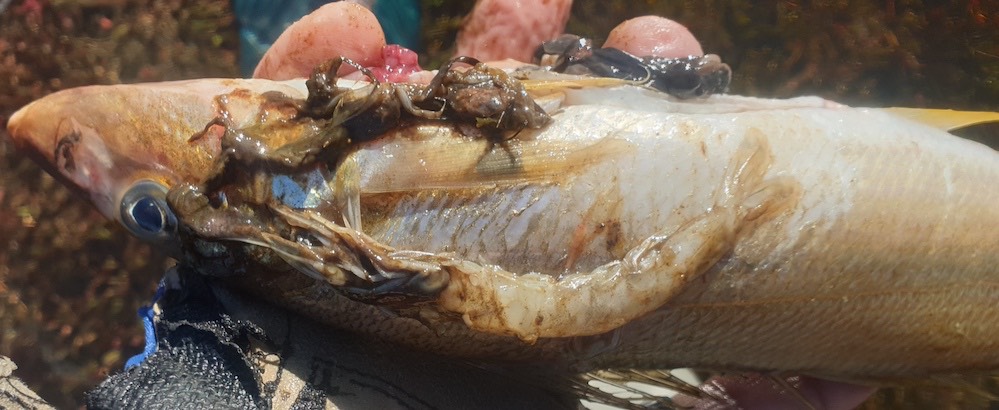
I took advantage of the warm weekend.
Given the tides, I selected an area that amplifies the small tide movement and works best on the slower tides.
I started with chasing Flathead on the falling tide. The Flathead are very active chasing the baitfish as they retreat to the shelter of weedy areas in deeper water.
Fishing for them in heavily weeded areas does present it’s challenges.
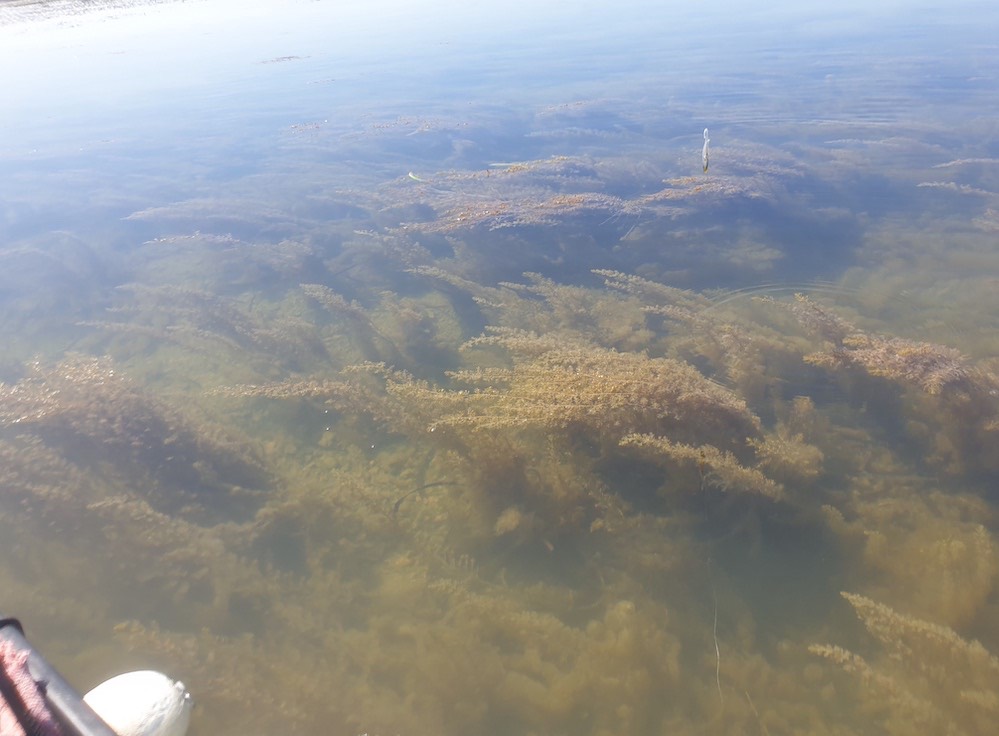
Lures with trebles catch too much weed. And when a Flathead is hooked they will head into the weed. All the exposed treble barbs, hook onto the surrounding weed and help the Flathead throw the lure.
I have recently started to use floating hardbodies like OSP Bent Minnows, with singles and assist hooks, for these areas. These hooks pull through the weed easily. So far, I have yet to have a Flathead throw these hooks.
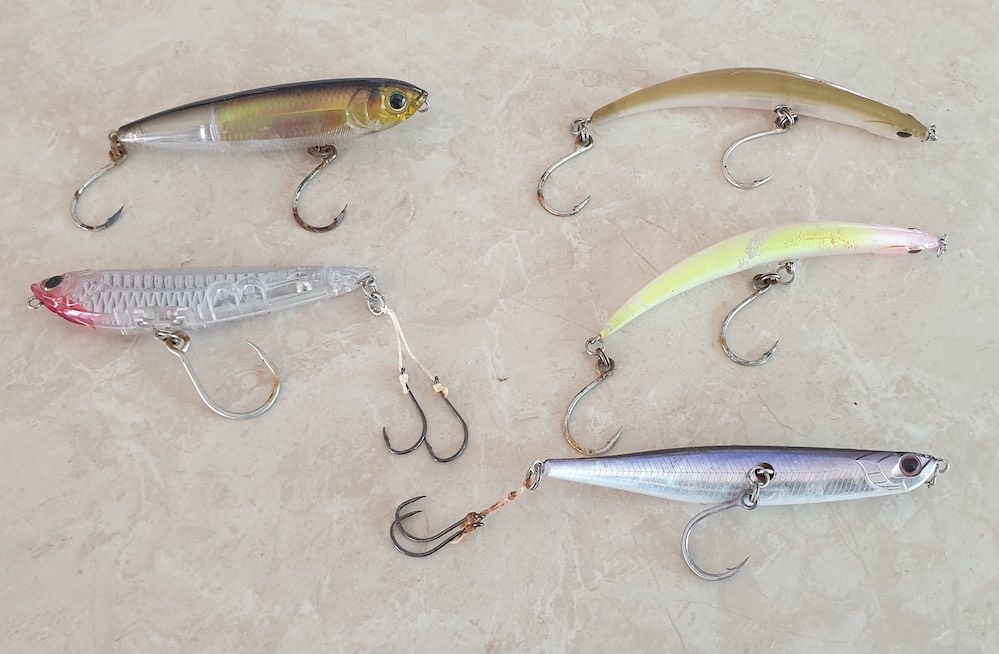
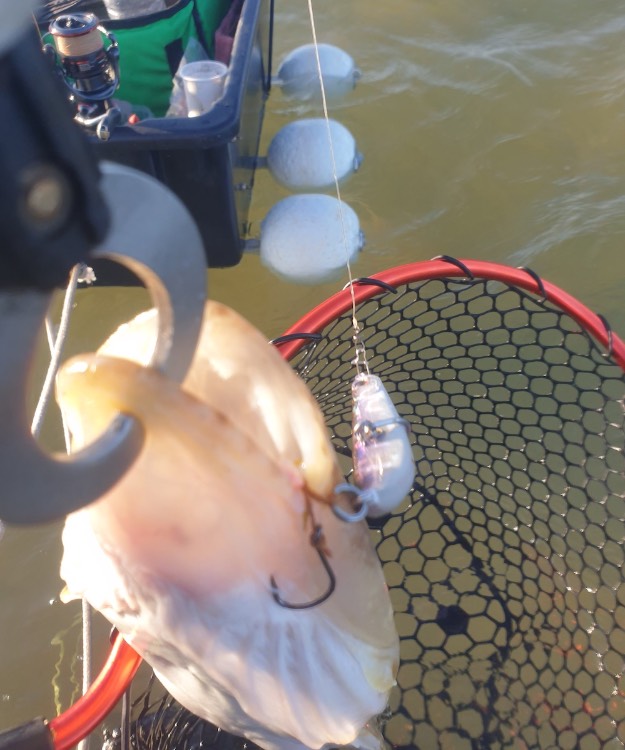
Look for where the Herons are feeding to show you where the baitfish are and the Flathead will be holding just downstream.
I was able to extract 3 Solid Flathead that were hiding around the weed, terrorising the baitfish, before the tide slowed.
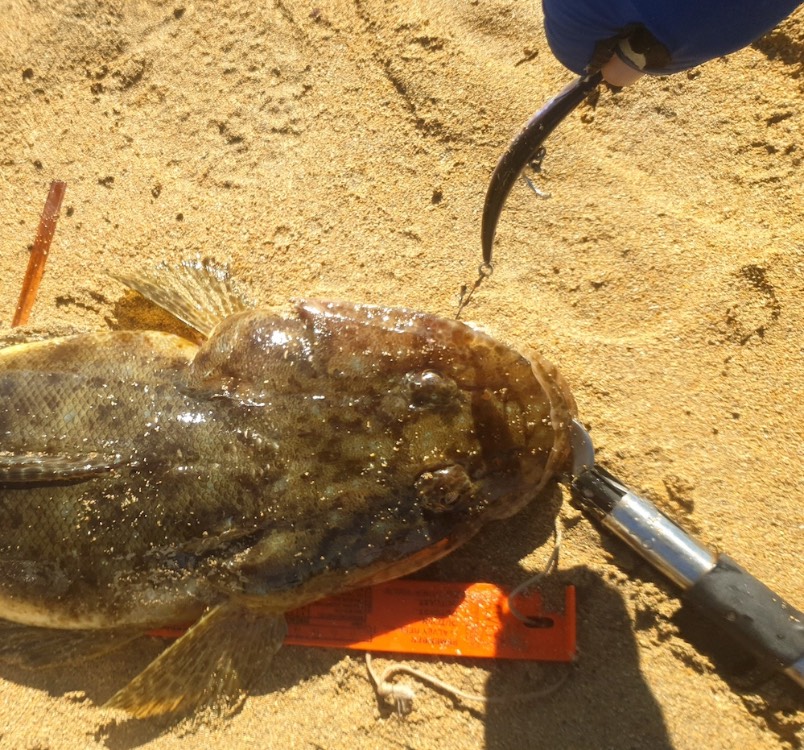
Next on the agenda were the YFW. A good depth of water was holding over the softer feeding sandflat areas. Usually you will find this substrate holds more food and fish.
Whilst not feeding as aggressively as when there is more water movement, the YFW were still keen enough to take a well worked lure offering over the sandflats. My usual favourites, Sugapen, Ecogear ZX and Zipbaits Skinny Pop, were the more successful lures.
However it is a new season and there are always a few new offerings to try out.
They did not get too much time in the water but both these new lures took fish.
The New Sugapen Splash, which is perhaps better suited to a choppier day still took a fish.
Daiwa’s Slippery Dog 80cm in the colour “Ebi” that I had not previously come across, I thought could work well in this area, had some success.
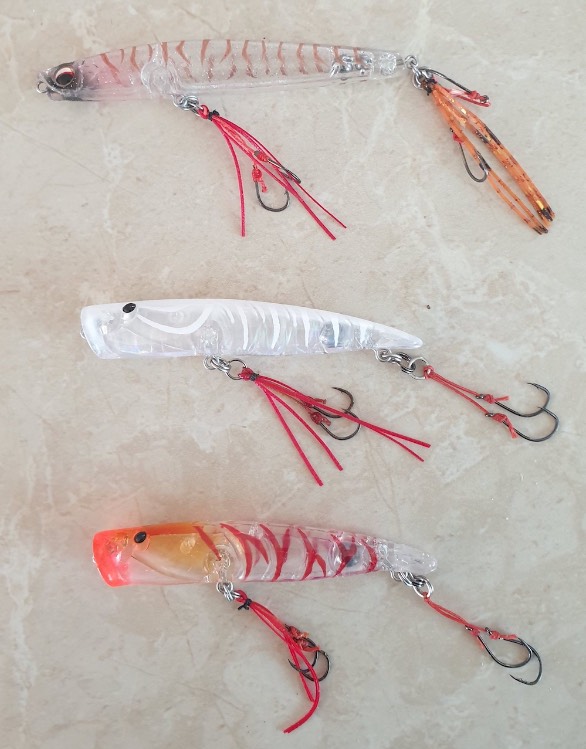
A drop in air pressure with a change in wind direction from North to SW, pushed water up into the gulf and provided a small wind tide. The water movement, stimulated the fish to bite late into the afternoon. “Bob the bag snatcher” is also making an early season appearance. I normally don’t see them on the sandflats till November.
I kept 14 of the better YFW. Most are over 35cm. And the best a very nice 42cm.
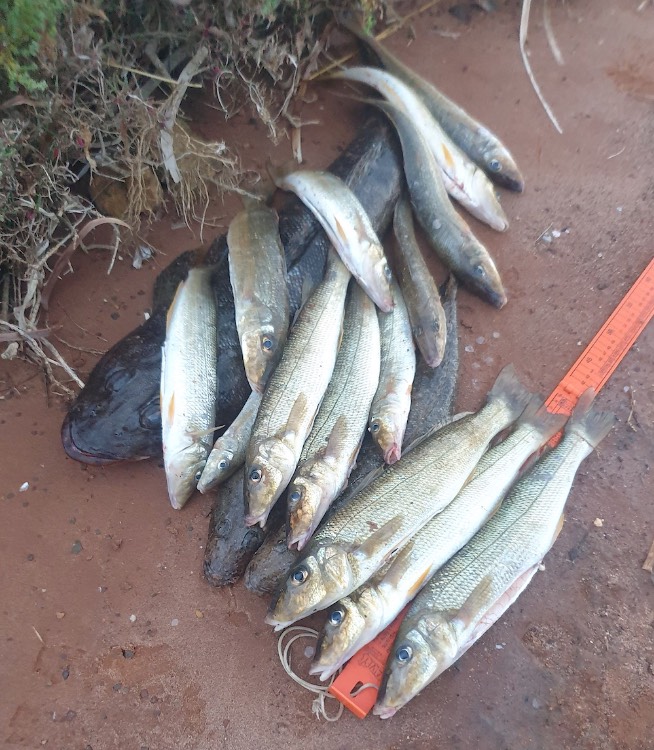
The Flats are Firing early this year !!! Hopefully we can look forward to a great season ahead.
The only downside is the heavy toll the professionals have taken over this winter as they increasingly search for alternative species to supplement their restricted and dwindling catches.
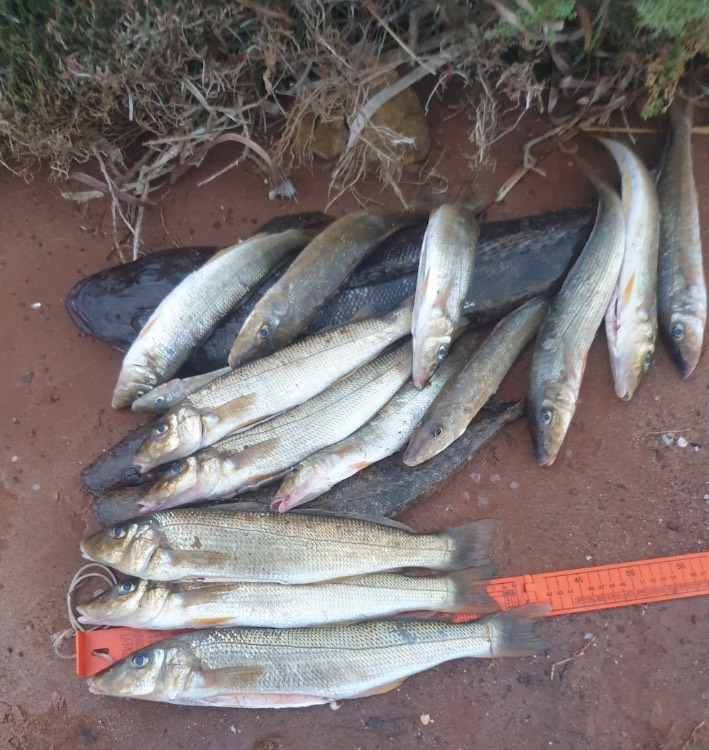
Tight lines all.
Cheers, Des
-
-
-
Could all members add to a list of Scam Stores in this thread.
I recently came across this store:
https://www.shimanostore.com/spinning-reels-shimano-vanford-2500-hg-spinning-fishing-reel/
It just seemed too good to be true !

A few checks on the web highlighted it as a scam store
- Bilbobaggins, Meppstas and doobie
-
 3
3
-
14 hours ago, Wert said:
My colour preference is basically the same as Kelvin's, Green being my favourite since I caught my first squid on a green jag 35 odd years ago and literally thousands since.
MAH's selection wouldn't make me sad either, indeed I'd be confident of cleaning up with what he picked and the 3.0 size is the most versatile in my opinion also.
As mentioned squid are pretty easy most of the time and will take any quality jag but small natural colours can make the difference in touchy squid in clear water and large bright ones seem better in murky conditions, some glow definitely seems advantageous at night.
Somewhat counterintuitively black also can be great in lowlight or murky conditions, the theory (I first saw 35 years ago in fishing mags RE night fishing for bass in NSW) is black creates the best silhouette, I was not a believer until I got stuck with a mates black sephia similar to Kelvin's second from bottom on the right in the yak selection, absolutely destroyed 3 other guys 2 to every one between them over 2 days in murky conditions and at night on various jetties both sides of YP so I'm now a believer and have never looked back.
I suspect that the same would hold for your YFW if it was murky or if you were mad enough to have a crack at night.
Thanks for the input Wert. There is a bit of common ground with all the recommendations.
I have fished often at night for YFW ... on bait. Have not had success with lures after dark.
But i just might adapt some of the concepts from the squid jag and see how we go.
-
-
3 hours ago, MAH said:
When squid are schooled up, any jig will work. But when you need to put in more effort, the better quality jigs do make a difference in terms of how they sink, dart through the water and sit on the bottom if you let them fall all the way (you want them to sit at 45 degrees with the barbs up to reduce the chance of snags and to increase the hook up if a squid snatches off the bottom).
Rui is a brand that can be bought from many tackle stores and they have an online store. Excellent balance between quality and price. Yamashita can also be found in many stores and online, the Sutte R range is probably on par with Rui for quality.
Duel and many Yo-Zuri jigs are not as readily available in store, but can be found easily online. There are excellent quality jigs and often have added features like silicone legs that waft and create extra movement or they rattle when jerked. These extra features are not absolutely needed, but can help when the squid are not fired up.
Thanks a Million MAH.
If I correctly recall, was it you that put up an extensive post on Squid fishing? I could not find the section in which you posted. Could you put a link to the post here please.
Better still perhaps @doobie or @bjorn2fish could relocate to the "Squid fish Files" for ongoing reference.
Cheers Des
-
5 hours ago, Kelvin said:
Thats a hard one. I rotate jigs every trip and have different favorites each season and also as the season changes.
I asked strictly for 3 only ,,, and you offer FIVE !!!

But judging from that collection on your wall, Totally understandable

I am a newbie to Squid fishing, however a grandson visiting in November, insists we go catch one.

Kelvin, now that you have started, you will have to elaborate on the "glow Jigs"
THANKS

-
Spring has sprung with a couple of days of warmish weather getting it started.
It seemed a good chance to try Lure fishing Yellow Fin Whiting and kick off this season with perhaps a catch or two.
The YFW lure box has not seen daylight for awhile. It was time to freshen up the lures by replacing the now well rusted out assist hooks on them.
The reels have been greased and oiled up. Trying best to prepare them for a season of abuse and dunking that wading fishing will inevitably deliver them.
All prepared I set off for a couple of days in search of my first lure caught YFW for this season.
The plan was to fish both warmish days ahead, determined to get off the mark for the season. I had also planned on fishing two different areas on either side of the upper St Vincent Gulf, hopefully increasing my chances.
Day one, was a hard slog with barely a YFW sighted. But plenty of Flathead about. The other variety that comes to life in Spring on the Sandflats. I spooked a few. I dropped a couple. I had not prepared my lures by replacing the rusted hooks. They certainly will be a focus of my next session.
I had to resort to bait to find a few YFW and keep me informed as to the whiting’s presence and whereabouts.
Day two, which I felt might be the better day, as a result of the water warming after a couple of warm days. It proved to be the day.
It did take some effort with fish finally taken later in the day on the incoming tide. Again, probably the warmest weather spell of the two days.
I did not experiment at all with any new lures and stuck to my old favourites of the Ecogear ZX and the Bassday Sugapen.
Only 2 of the 8 lure caught fish were taken on the surface. Their body temperatures and metabolisms are still low. Making them a bit lethargic to be aggressive surface predators. As in past seasons the sub surface lures usually starts the season more successful.
Another influencing factor is, awaiting the arrival into the shallows, of the new season’s juvenile prawns from their annual, mid gulf spawn. The availability of this seasonal food source will also stimulate predatory surface feeding behaviour.
There is a considerable difference in water temperature on the two sides of the St V Gulf. The Eastern side being far shallower, is the first to warm up. The Western side was significantly cooler. However this will soon even out after a more prolonged spell of warm weather.
There are signs of a promising season ahead with some very hot conditions predicted.
Every cloud has a silver lining.
- yellow door 1, Mickyj, Hunter69 and 6 others
-
 9
9
-
I can only take 3 squid jigs on a trip. Thats it.
Which 3 will they be?
What Colours, Sizes, Brands?
Which 3 will provide best chances of success in all scenarios ?
Thanks Des
-
Another I have tried without luck. From Storm Lures.
This one is very stiff.
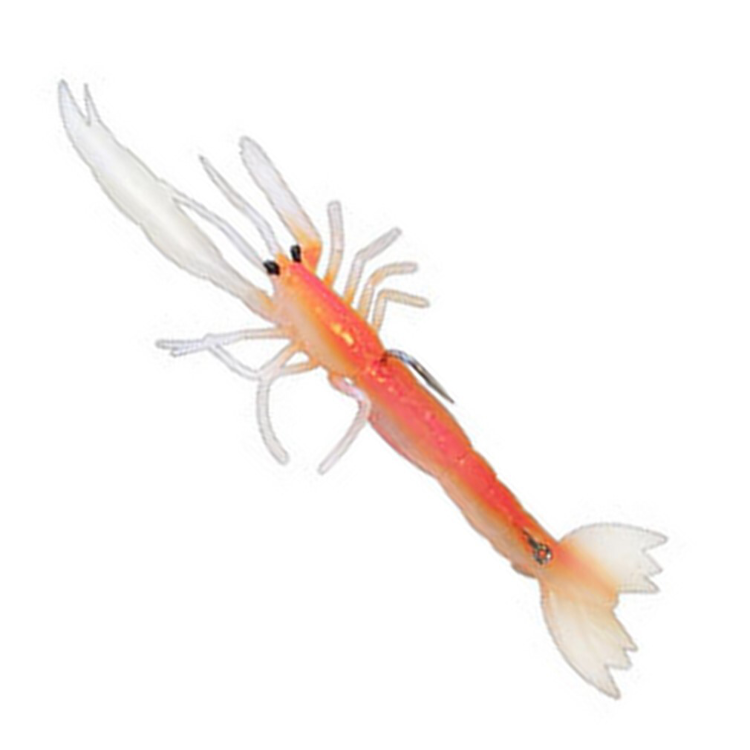
-
-
The material is really good. I have taken KG at the weedline with the Bait Junkie critters. But no YFW. Probably as I have not flicked them out in prime YFW territory.
There are a few Clicker like presentations.
This Aussie company make a good one. Their "Salt Water Yabbie" Their material is stiffer, but then Clicker bodies are fairly stiff. They have worked well.
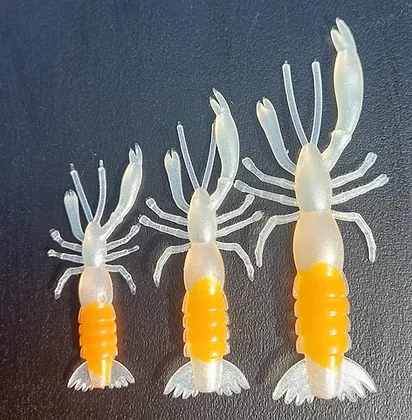
-
Oversupply !!! at present.
Winter is when the professionals catch the most tonnage.
I had covered it in this post:
Graphs of the monthly catch rates.
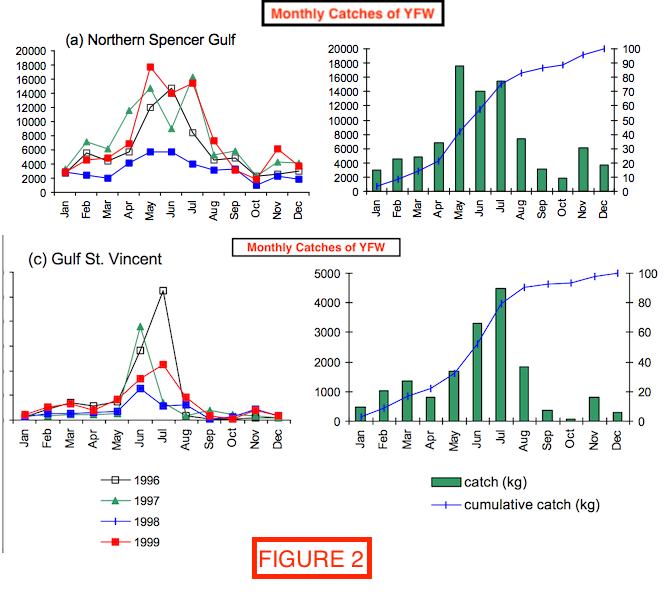
-
-
-
-
Yes the sprays work. As it gets overcast I do spray it on my regular lures to add that UV attraction to them. However the spray are lacquer based and have an un attractive smell. the Lacquer spray dries fast and then I do cover it with S Factor or similar.
I think S factor works better with the slower moving lures.
I covered it in this previous post;
An extract from that post:
" ADDED ATTRACTANTS"
"UV sprays have proved to be effective on overcast days. It has brought a quiet session to life for me.
No worries if you don’t have UV lures on you. A Spray on UV coating can convert your standard lure to a UV lure.
Scents? … I think they work? At least they have not put any fish off! I have used them without any definitive results.
It probably is more effective with a slower moving and pausing lure when Bream and Flathead fishing.
Those fish get more of a chance to have a sniff of the lure. I have noticed better results when using slow retrieved blades with added S Factor scent.
Scents have less impact with the faster, continuous moving surface lures for YFW. Yet I continue to use it now and again. No harm."
Worth experimenting with.
An interesting article on UV and fluorescence
https://www.abc.net.au/science/articles/2003/11/17/990551.htm
-
Nice fish.
 Very satisfying to catch it on your own fly
Very satisfying to catch it on your own fly 
-
-
TERRAIN: HIGHWAYS TO THE FEEDING ZONES … You can sign along to this post !
Yellow Fin Whiting have been showing up in good numbers in both gulfs recently.
But you still need to find them, and fish the right spots … at the right stage in the tide.
YFW are always on the move. Actively feeding on a moving tide. Both in and out going tides.
But there are dead transit zones, over which they will pass through without providing you much of a chance to catch them. These are merely the … Highways to the Feeding zones.
The feeding zones is where you want to be fishing.
In each YFW Habitat there are transit zones and feeding zones.
In the upper gulfs the coastal environment contains a lot more mangroves and samphire beds. Nearest to shore and onshore are the Salt bushes and Samphire bed areas.
On many stretches of the upper gulfs they will also be a mangrove forrest wall.
Through these mangrove forrest flow many small tidal creeks and channels, that pour in and out onto Sandflats. The Sandflats drain out, eventually meeting the ribbon grass weed beds.
In the lower gulfs, the terrain is slightly different without Mangroves and less Samphire.
They are replaced by open sandflats, sometimes with a little scattered reef, and banks of fine seagrass weed beds, that drain out to a weedline of ribbon grass.
Each area has it’s own characteristics and features, which influence the movements and feeding behaviour of the YFW. The all have their transit zones and their feeding zones.
.
WEED LINES.
We start at the deep end, the weedline. This is the first of the habitats in which we find YFW.
The deeper seaside of the sand flats are always bordered by the weed line of sea grass beds. These are usually Ribbon weed or tape weed beds (Posidonia varieties). Often this will be where the bottom of the low tides hold. And were the YFW take refuge on the low tides.
In the lower sections of the gulfs, their cousins the King George Whiting also keep them company at the weed line. Along with many a Flathead too.
The best spots for land based KGW are the weedline areas that receives a natural berley stream from sandy shallow drains, running off the sand flats.
This habitat is also a favourite for Flathead, which take cover in the weed edges and like to ambush baitfish straying too close.
You will find the larger YFW hanging around here, mixing it with the Flathead and KGW. Large YFW have the speed and morphology to take minnows at the weedline. They are able to chase them down along with any Shrimp that may have come out of the sheltering grasses.
The barrier like structure of the weed beds will mean there is always some channeling through the weed beds, caused by the tidal flows. These channels are the main flow areas during tidal movements, on and off the sandflats.
Focus your fishing at these channel openings, both at the bottom and at the start of the tide.
And in a dodge tide, it is the only place to be. The minimal water flows of a dodge tide will be greatest at these channels, and so stimulate the YFW to feed in that area.
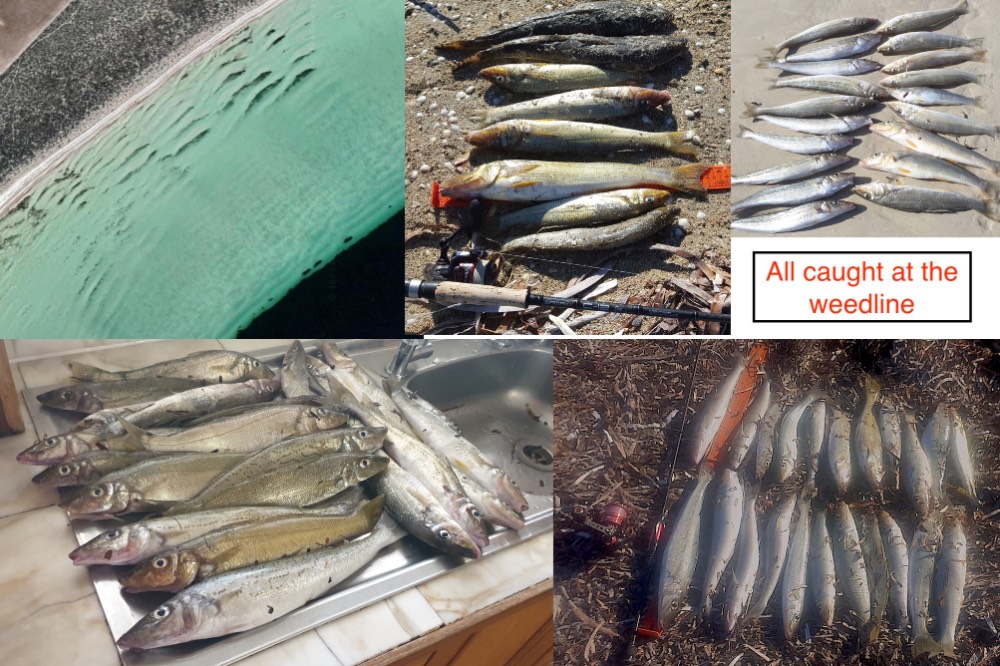
~ King George Whiting, Yellow Fin Whiting and Flathead all found down on the weedline.
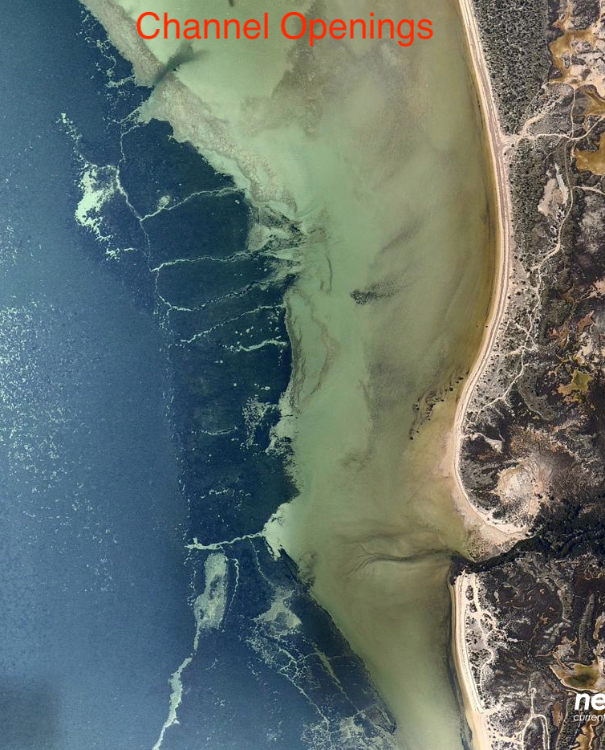
~ Find the water flow and fish at the channel openings
SANDFLATS
Sandflats … are never Flat !!!
Sand flats don’t always slope seawards in a continuous gentle gradient. They is more often a series of ridges, gutters, bowls, channels and steps leading down to the weedline.
These are not necessarily dramatically obvious. A 4” to 5 inch depth difference is a significant change in these shallow sandflats.
These structures and variations in the sandflat terrain are the most obvious fish holding areas. The slightly deeper areas of the shallows, are the first areas that YFW will retreat into on a dropping tide, or swim into and hold in, on the incoming tide.
Fish always hold at steps and drops on the sandflats, wether it be the run in or run off.
They prefer to feed on the shallow edges of any deeper water areas rather than in the deep water itself.
If in a fast flowing channel focus on the slow side of a bend in the channel. It is where food would naturally settle and fish will feed. It is where the benthic organisms colonise more with out fear of being swept out by a fast moving tide.
Shallow weed beds of finer bladed, lawn like, seagrasses ( Zostera varieties) are often found on the more open flats lower in the gulfs. They are important for the movements of YFW during the tidal flows. In very shallow water YFW will tend to favour moving along the weed bed edges and take cover in the weed beds. It is an ideal spot to target them in ankle deep water. The water is always a bit deeper alongside the edges of these fine grass weed beds.
Should the wind be a bit strong, YFW will hold on the Leeward side of these beds a bit more. And on light winds with gentle lapping waves, the windward side of these weed beds.
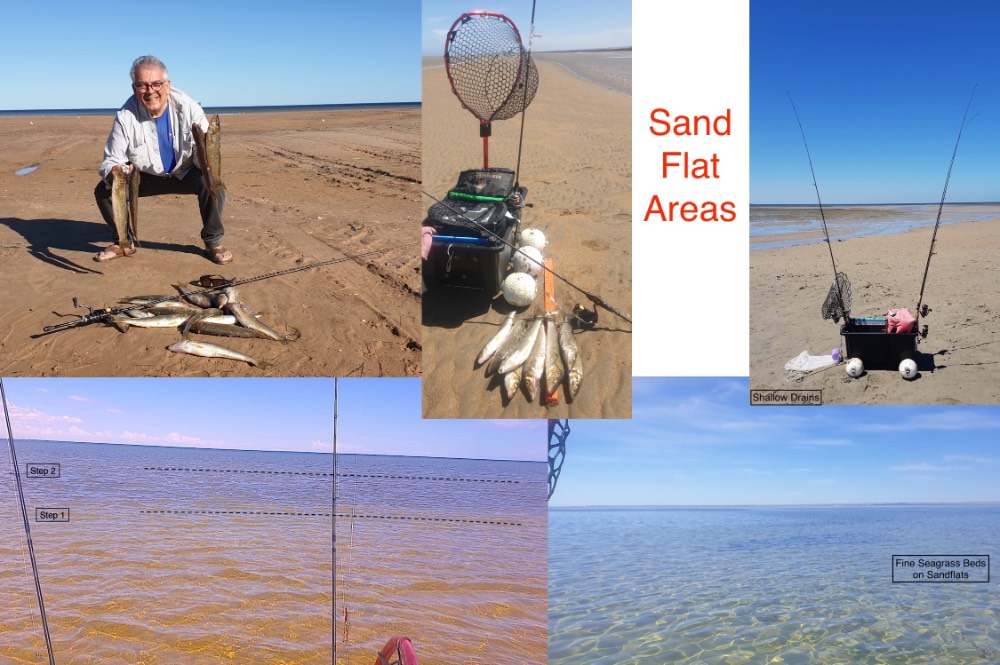
~ The small variations on the sandflats hold the fish
SUBSTRATE on SANDFLATS
Regardless of upper or lower gulf areas, you should identify the substrate that you are fishing on.
As a wading fisherman you can feel and identify the different substrate underfoot.
It is simply either, coarse, gravelly and hard, or soft, silty, and sandy.
I usually move on quickly from the coarser, gravelly areas and onto the finer, siltier, sandy areas.
Coarse gravelly limestone or shell grit areas are not as productive. They do not hold the YFW food so don’t hold the YFW long. It often is a faster flowing area and a transit zone for fish.
You will still catch the odd few YFW as they use it as a highway to the feeding zones. But they won’t hold and feed there.
The feeding zones are characterised by finer, softer, siltier sand beds. Which holds a lot more YFW food. This is where all the benthic dwelling creatures, like cockles, worms and clickers live. All the juvenile prawns that we see leaping around on the surface at night as nocturnals, now bury themselves for the day in the soft sand and silt.
YFW linger a lot longer in these softer sandy areas searching for and feeding on the food it holds.
MANGROVES
Bordering the sandflats on the shoreside in the upper gulfs are often mangrove forests. Amongst the mangrove forest there are clear water ways that channel the considerable tidal movement experienced in the upper gulfs. The tides flow through tidal creeks and mangrove openings and into the samphire beds, or out onto the sandflats. These mangrove openings will hold a greater concentration of fish when the tide is moving.
At times the thick growth and dense mangrove canopy can totally conceal an opening. There are however some tell tale signs of a concealed creek or channel. Ever wondered about those Shags, that regularly congregate on certain mangrove trees overlooking the sand flats. It’s the Shag breakfast club. The shags are there because there is food flowing out there. Minnows, Shrimp and Prawns are being brought out on the falling tide through a creek concealed by the mangrove canopy. The larger YFW are not threatened by the Shags and will also hang out the front of these spots.
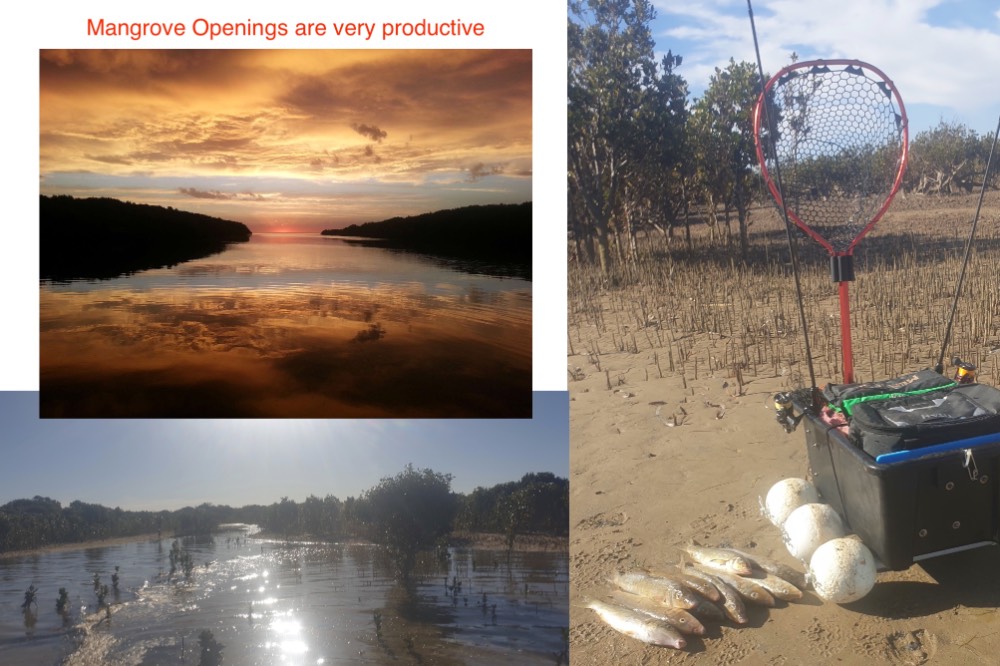
~ Mangrove Openings have high flow rates and hold fish
SAMPHIRE BEDS
Once past the mangroves there are obvious narrow channels through the samphire beds. These are invariably gravelly rarely holding benthic species. But they will hold and concentrate YFW passing through that can’t help but see your offering. The YFW like to move up into the muddier samphire bed areas primarily to feed on Haswells crabs and small mud cockles. This is a highway on which you can actually take a toll.
Great spots are Junctions, like one I nicknamed “Gepps X”. It does bring to together a concentration of fish. Even if only a relatively short time at the right time of tide. You can even catch YFW by hand at night in these narrow and restricted spaces.
Google satellite images are the most useful tool you have to help you find the spots and plan your strategy for the incoming and outgoing tide.
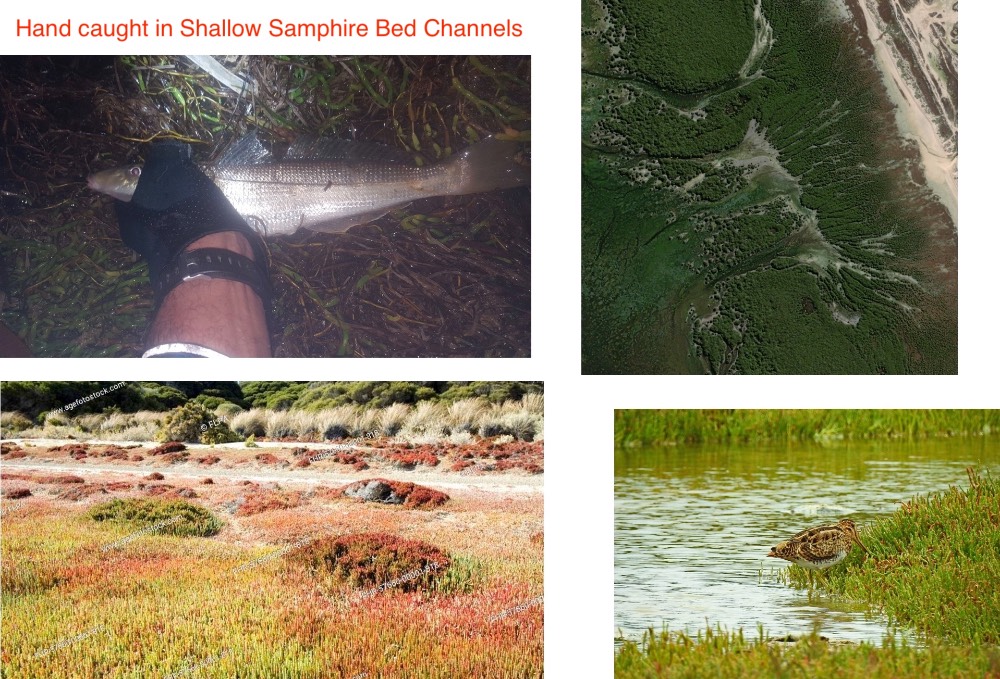
~ Fish move into the channels of the Samphire beds
OPPORTUNISTS
This has nothing to do with the terrain. Try casting lures around feeding Eagle Rays on the sandflats.
The YFW often hang around feeding Rays hoping to pounce on food that the Ray has dislodged.
They are in a switched on and opportunistic feeding mode, ready to pounce.
Just offer them your lure instead! This has worked well on a few occasion.
And in the better years now past, when the YFW biomass was not that badly decimated by the pro netting activities, they would also hang around swimmers on metro beaches, in the hope of some dislodged food.
.
~ A nice Catch wading for YFW
As keen Hunters and Gathers, we always need to stay alert to and aware of all the features in the fish’s habitats and how they will effect our catch rate.
Tight lines all.
Cheers, Des
-
2 hours ago, yellow door 1 said:
The new elasticated leader spool maintenance system made from a sushi soy sauce bottle lid
Always inventive

-
1 minute ago, Territory Lad said:
Those ZX's have taken a beating, especially that bottom of the three. I imagine the missing rubber "feelers" don't hinder the YFW catch rate?
Side question, what size vanford you running these days? 2500 or 1000?
As a lure that bounces across the bottom there is always going to be a bit of wear and tear on them.
They do have a diminishing catch rate as they loose their paint and extra feeler bits.
On the Reel question ... I use the Vanford 2500
The bigger spool provides a bit better cast. Also and importantly, the larger diameter provides me with a better retrieval speed for the lures.
- Territory Lad and TENNANT
-
 2
2



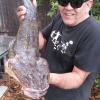

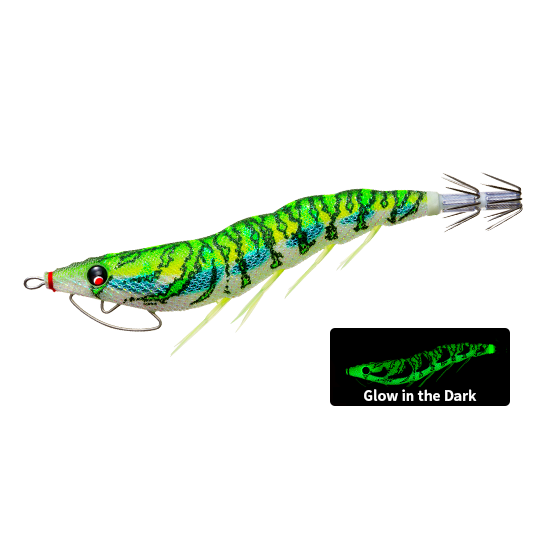
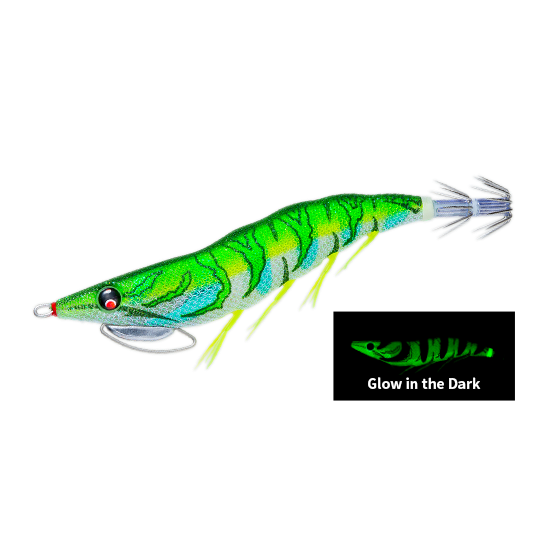
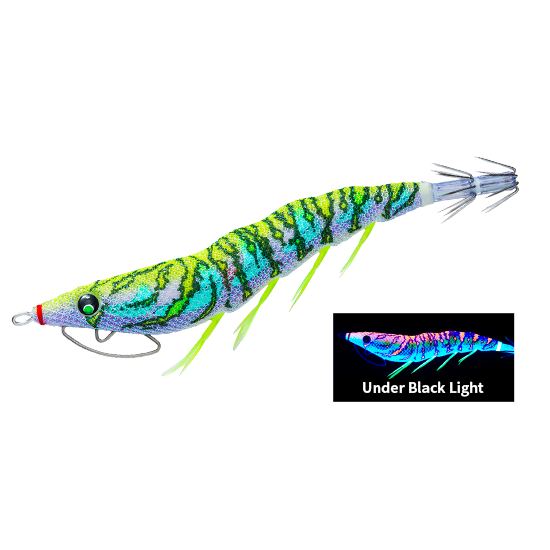
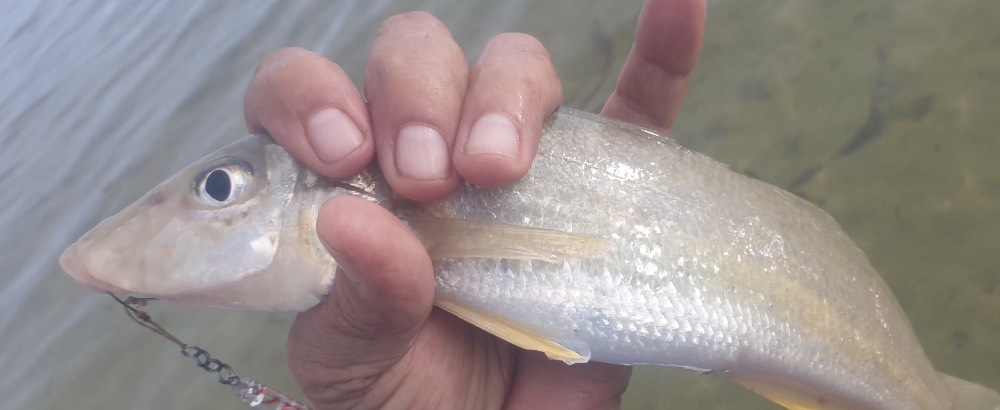
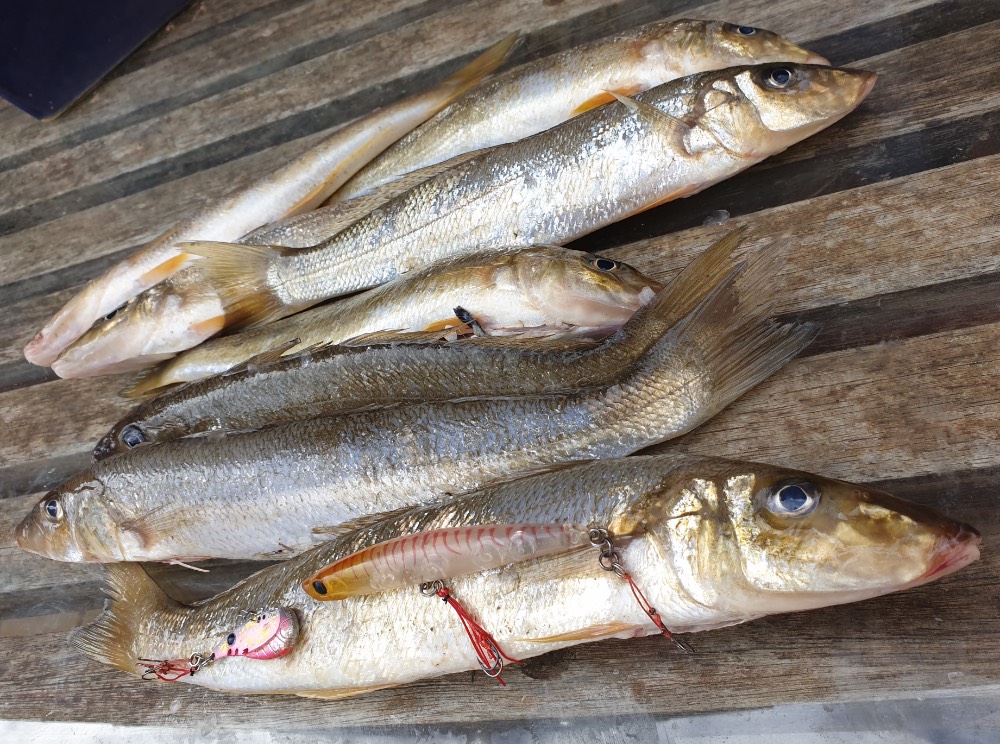
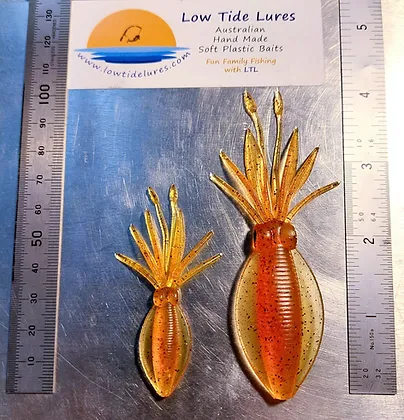
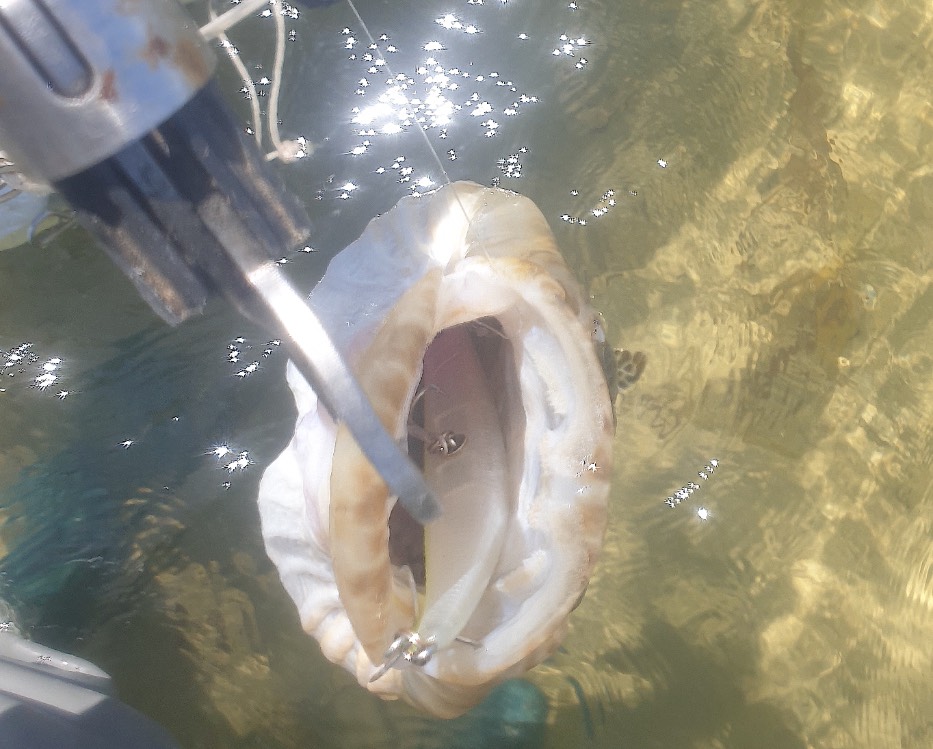
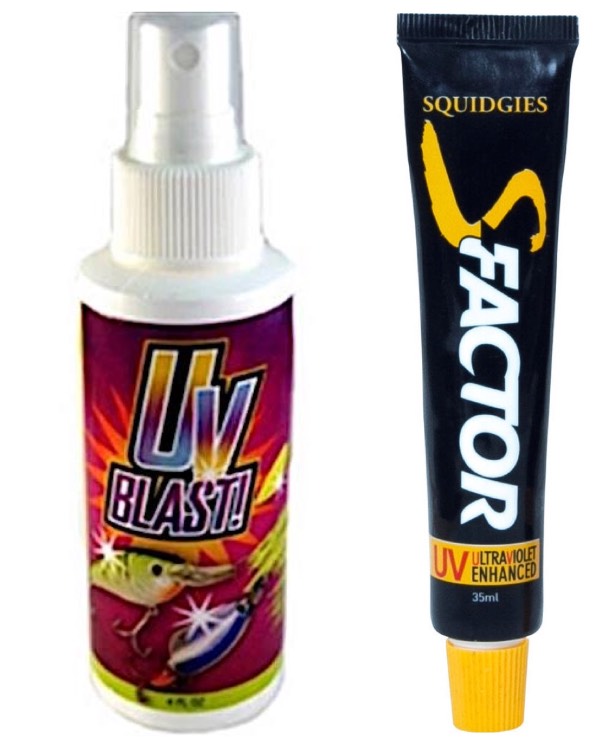
DONKEYS on the DODGE TIDE
in Yellow Fin Whiting
Posted
Regular post readers will know I like to fish the dodge tides for Yellow Fin Whiting .
I cover a variety of reasons in detail, in this previous post:
.
One very good reason, is that you will regularly find better quality fish on the dodge tide.
YFW movements and feeding are highly influenced by the tide. Revolving around the largest tide of the day, they tend to have a 24 hour digestive and feeding cycles.
So even when the tides do not move much on the dodge, they will still have a need to feed within their cycles. The larger YFW have greater food needs and will generally preference a bigger meal such as juvenile prawns or clickers.
With the small dodge tide their feeding will be concentrated to the smaller area, covered by little water flooding in. They will be easier to find.
The terrain/substrate that holds their preferred food will naturally attract a higher concentration of larger YFW.
That terrain you can feel under foot. The softer food holding substrate.
The small tide movement, along with a deeper low tide, holds water over these prime feeding grounds longer. It provides for prolonged access to this zone for both fish and fisher person.
A better explanation of productive terrain is in this post :
.
The dodge tide on Monday with a High of 1.77 mt @ 8.15am and a Low of 0.97 mt @ 11.36pm provided a long drawn out, run off tide. With a prolonged spell under water, of some prime food holding areas. It looked like an ideal tide and I set off fishing.
YFW are always stimulated by tide movement to feed. These tides do not provide much of that stimulus. However there are other factors that come into play.
.
The day started slowly without a strike for the first hour. The warmth of the day gradually started to take effect and the first to stir were some small Whiting.
With the warming arvo came an arvo seabreeze, as well as a predicted strengthening southerly wind. YFW love a heavy rippled surface to take cover under and lose their feeding inhibitions. The bite picked up strongly and catches were now steady. In the constrictions of the upper gulfs any lower gulf southerly wind can force water up. A wind tide pushes in. It further stimulated the YFW and kept the feeding grounds covered with a perfect level of water for a wading fisherman.
.
I caught my bag of 20 in good time. This situation regularly provides quality fish, with10 of the fish ranging from 38 to 41cm. Most of the remaining 10 fish were around 35cm.
Sugapen 95 was the most successful lure. Then again I did not need to use a lot of variety.
The new Sugapen Splash caught it’s share when the afternoon breeze picked up. This is shaping up as the perfect lure for that strong summer afternoon breeze that kicks up a bit of chop.
A few were also taken on the Ecogear ZX, when I was forced to go subsurface as a pack of persistent juvenile seagulls are yet to learn lures don’t taste good.
.
Hopefully we have some more fine weather for the next dodge tide.
Tight lines all.
Cheers, Des